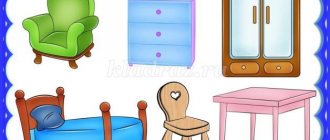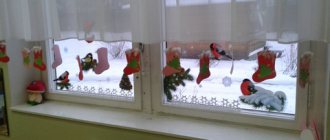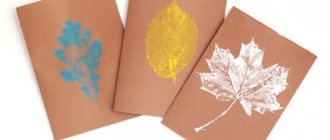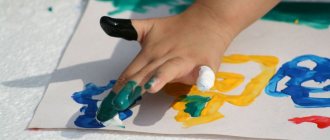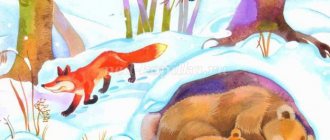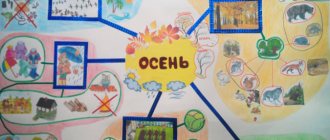Summary of the lesson on FCCM in the first junior group “In a forest clearing”
Goal: to teach children to draw a spring flower in an unconventional way.
Tasks:
• Continue learning to draw with a sponge on a piece of paper;
• Learning to draw flowers using the “dipping”
• develop imagination and perception of the surrounding world, develop fine motor skills;
• Consolidate knowledge of colors (yellow, red, blue);
• cultivate a caring attitude towards nature, form an emotionally positive attitude towards the drawing process itself.
Equipment and materials: Musical recordings (bird voices, murmur of a stream, buzzing of a bee), soft toy: Maya the bee, sponge, yellow gouache, flower meadow, pictures of dandelion
Preliminary work: reading books, memorizing poems, looking at paintings “Flowers in Spring”
, conversation about spring, observing changes in nature in spring, looking at insects.
Progress of the lesson:
Children sit around the teacher, a melody with the sounds of spring sounds.
Educator: Guys, let's listen to what beautiful music it sounds. What did you hear?
Children's answers.
Educator: What time of year do you think we can hear these sounds?
Children's answers.
Educator: That's right, we can hear all these sounds in the spring.
Educator: Guys, what happens in nature in the spring?
Children: Everything is waking up. With the arrival of spring, the sun began to shine brighter, it warms us very much.
Educator: At this time, insects appear. Do you know where they live (in the forest, in the city, in the park)
I invite you today to a forest clearing to visit insects.
Do you agree? Went!
Educator: We went out to the forest clearing, raising our legs higher.
Through bushes and hummocks, through branches and stumps.
Who walked so deftly without tripping or falling?
They approach the model of the clearing, covered with a green tablecloth with flowers.
Educator: Well, here we are! Look what a beautiful clearing! What do you see on it (flowers)
Name what color they are (red, yellow, blue, etc.) Let's sit down in the flower meadow, relax a little, admire the flowers.
Educator: Oh, children, do you hear? Who's buzzing?)…
Children: Bee.
Educator: Hello, bee!
Maya the Bee: Hello guys. My name is Maya the Bee! I got into trouble. Soon my bee friends will come to visit me; they really love flower nectar from dandelions. But I have nothing to treat them with, because there are still very few dandelions in our clearing. And I really want to collect a lot of nectar and treat my friends. Maybe you can help me?
- Children, where can we get dandelions?
- Yes, guys, I also think that we can draw dandelions.
But first let's play
PHYSMINUTE
Imagine that you are dandelions and growing in this clearing ( Children squat)
— Dandelions are starting to grow. Grow, grow - grown!
The wind blew and the dandelions swayed.
Evening has come, the dandelions are closing.
Morning has come - the dandelions have woken up and are nodding their heads.
Educator: Have you rested?! Now let’s all sit down at the table and look at the picture of a dandelion. What dandelion?
Children: Beautiful, yellow, round.
Educator: What are flowers for?
Children: To admire them.
—What does a dandelion flower look like? (in the sun, on the ball).
Educator: Today we will draw with a sponge.
“I’ll show you now how we’ll draw flowers using a sponge.” Dandelion, what color?
Children: Yellow.
— We dip the sponge in yellow paint, then “dip it in”
on the green grass. You get beautiful yellow dandelions.
The colors suddenly became like flowers, Lighting up everything around!
In the new yellow sundress Dandelion Meadow.
- Well done guys, you tried really hard
What wonderful flowers they turned out to be. Now let's place the dandelions together in our clearing - it turned out very beautiful. We will get a large dandelion meadow. - Guys, what do you think, is it possible to pick flowers just like that? Trample them underfoot? On green grass, yellow dandelions are very beautiful. Although there are a lot of them, you shouldn’t pick them.
Let's not pick dandelions and preserve beauty. And the bees will thank us for saving the flowers for them.
Oh, here our bee has arrived! That's how great!
-Bee: Oh, thank you, guys! Like there are many flowers in the meadow, I will now collect a lot of delicious nectar and treat it to my friends.
Subject:
"In a forest clearing"
Goal: to teach children to draw a spring flower in an unconventional way.
During the lesson it was expected to solve the following problems
Tasks:
• Continue learning to draw with a sponge on a piece of paper;
• Learning to draw flowers using the “dipping”
• develop imagination and perception of the surrounding world, develop fine motor skills;
• Strengthen knowledge of colors (yellow, red, blue);
• cultivate a caring attitude towards nature, form an emotionally positive attitude towards the drawing process itself
When developing this lesson summary, I first of all took into account the age and mental individual characteristics of the children of the first junior group.
Preliminary work was carried out with the children: reading books, memorizing poems, looking at the paintings “Flowers in Spring”
, conversation about spring, observing changes in nature in spring, looking at insects.
During the lesson, the children were active - they participated in the game and answered questions.
The children's interest remained throughout the lesson. The children were attentive
I believe that I was able to fully implement the assigned tasks.
GCD Subject activities and games with composite and dynamic toys
State budgetary educational institution Samara regional basic secondary school No. 21 named after Hero of the Soviet Union E.A. Nikonov of the city of Novokuybyshevsk, urban district Novokuybyshevsk Samara region structural unit "Kindergarten "Terem-Teremok"
Outline of GCD Subject activities and games with composite and dynamic toys
For the first junior group
Theme: “Winter fun”
Prepared by:
teacher of the joint venture “Kindergarten “Terem-Teremok”
Sklyanina O.A.
2019
Plan - outline of educational activities directly
Object activities and games with composite and dynamic toys
For the first junior group
Subject:
"Winter Fun"
Integration of educational areas:
“Speech development”, “Social and communicative development”, “Cognitive development”, “Artistic and aesthetic development”, “Physical development”.
Tasks:
1. Give children basic ideas about winter activities and fun (Cognitive development)
2. Form the rules and skills of cultural behavior during the day and in communication with adults and peers (Socio-communicative development).
3. Develop children’s active speech, enrich their vocabulary, learn new words, teach them to understand adult phrases that are simple in content and construction (Speech development).
4. Development of motor skills, general motor skills, coordination of movements (Physical development)
5. Artistic and aesthetic development (drawing)
Methods and techniques:
Practical – games, exercises, experiments; visual – viewing, observing, viewing; verbal – questions, conversation, situational conversation.
Materials and equipment:
Subject pictures on the topic, “snowballs” made of cotton wool or padding polyester, pictures on the topic, paints, brushes, napkins, glasses of water, easel, sheets of blue paper, onions.
Form of organization of joint activities
| Children's activities | Forms and methods of organizing joint activities |
| Communicative | Conversation, situational conversation |
| Motor | Game exercises |
| Subject activity | games with balls, padding polyester balls |
| Fine | Unconventional painting technique (with bulbs) |
Logic of educational activities
| № | Activities of a teacher | Children's activities |
| 1. | During the walk, the teacher draws the children's attention to the fact that it is winter outside. Everything is covered with snow, the snow is soft, creaks underfoot, you can make snowballs out of it. | They show interest in the walk, listen to the teacher’s speech, participate in observation, look at the snow, touch it, try to make snowballs, and try to answer questions if possible. |
Article:
The methodological development was prepared for a workshop for young teachers of preschool educational institutions with the aim of implementing the educational program “Cognitive Development” in groups of early and junior preschool age in accordance with the principles of preschool education of the Federal State Educational Standard for Preschool Education.
One of the principles of preschool education of the Federal State Educational Standard is the formation of cognitive interests and cognitive actions of the child in various types of activities (text of the Federal State Educational Standard, paragraph 1.4.7.)
Cognitive activity is active activity in acquiring and using knowledge. The main task of a child’s cognitive development is the formation of the need and ability to think actively and overcome difficulties in solving various mental problems.
When talking about cognitive activity, Federal State Educational Standards for Educational Education use three terms:
- Cognitive interests are the child’s desire to learn new things, to find out what is unclear about the qualities, properties of objects, phenomena of reality, and the desire to delve into their essence, to find connections and relationships between them.
- Cognitive actions are the activities of children, with the help of which they strive to acquire new knowledge, skills and abilities. At the same time, internal determination develops and a constant need is formed to use different methods of action to accumulate and expand knowledge and horizons.
- Cognitive development is a set of quantitative qualitative changes that occur in cognitive mental processes due to age, under the influence of the environment and the child’s own experience.
The cognitive activity of preschool children should be understood as In young children, the development of their cognitive activity is of great importance. It is expressed in an interest in accepting information, in a desire to clarify and deepen one’s knowledge, in an independent search for answers to questions of interest, in the manifestation of elements of creativity, in the ability to assimilate a method of cognition and apply it to other material.
In accordance with the “Origins” program, ed. Paramonova L.A. Cognitive development at an early age involves the formation of ideas about the world around us, object-based activity, and construction from building materials and large parts.
At a young age, this is the development of ideas about the socio-cultural values of our people, about domestic traditions and holidays, about the nature of the immediate environment, its characteristics, about the properties of objects in the surrounding world, the formation of primary ideas about oneself and other people, introduction to the creation of simple structures from building materials and large parts.
The content of educational areas, according to the Federal State Educational Standard, depends on the age and individual characteristics of children, is determined by the goals and objectives of the Program and can be implemented in various types of activities (communication, play, cognitive and research activities - as end-to-end mechanisms of child development):
To effectively implement the content of cognitive development, the following types of activities are distinguished:
| Young children | Young children |
|
|
OOP Cognitive development is implemented in the forms of educational activities:
- Direct educational activities (DEA).
- Joint activity between an adult and a child.
- Independent activity of children.
- Regime moments.
For the successful implementation of PEP, the following psychological and pedagogical conditions :
1) respect of adults for the human dignity of children, formation and support of their positive self-esteem, confidence in their own capabilities and abilities;
2) the use in educational activities of forms and methods of working with children that correspond to their age and individual characteristics (inadmissibility of both artificial acceleration and artificial slowdown of children’s development);
3) building educational activities based on interaction between adults and children, focused on the interests and capabilities of each child and taking into account the social situation of his development;
4) support by adults for the positive, friendly attitude of children towards each other and the interaction of children with each other in different types of activities;
5) support for children’s initiative and independence in activities specific to them;
6) the opportunity for children to choose materials, types of activities, participants in joint activities and communication;
7) protection of children from all forms of physical and mental violence.
two main lines in the development of cognitive interests :
- Gradual enrichment of the child’s experience, saturation of experience with knowledge about the environment, which causes cognitive activity. The more aspects of the surrounding reality that open up to a child, the wider his opportunities for the emergence and consolidation of stable cognitive interests.
- Gradual expansion and deepening of cognitive interests within the same field of activity.
Features of the development of cognitive interest
| Young children | Young children |
| Visual-effective thinking predominates, so the baby can only understand what is directly in front of his eyes. The object of cognition is the surrounding objects and their actions. Children actively explore the world according to the principle “What I see, what I act with, that is what I learn.” The accumulation of information occurs through the manipulation of objects and the child’s personal participation in various situations. | Visual-figurative thinking predominates. By this age, children accumulate quite a lot of ideas and knowledge about the surrounding reality. However, these ideas are practically unrelated to each other. The child is only trying to establish relationships between ideas. |
Contents of pedagogical work
Young children (from 2 to 3 years old): Introduce children to generalized methods of studying various objects of life around them. Stimulate curiosity. Involve children in practical educational activities of an experimental nature together with adults.
Junior group (from 3 to 4 years old): Teach children generalized methods of studying various objects of life around them, using specially developed systems of standards and perceptual actions. Encourage the use of action research. Involve children in practical cognitive activities of an experimental nature, joint with an adult, during which previously hidden properties of the object being studied are highlighted.
With the entry into force of the Federal State Educational Standard, cognitive and research activities , along with games, become the most relevant form of organizing the activities of preschoolers.
It is necessary to organize cognitive and research activities of children taking into account:
- age and individual characteristics of children,
- integration of the content of educational areas,
- subject-spatial developing educational environment,
- interactions with family.
The task of educational activities of young children in the field of “Cognitive development”:
- Support children's curiosity.
- Develop interest in joint learning with adults and independent learning.
In order for cognitive and research activities to successfully develop and be carried out in groups, experimentation corners are created. Equipment for the experimentation corner in the junior group:
- natural materials: sand, clay, earth, stones, acorns, pine cones, beans, flower seeds;
- iron, rubber, plastic, wood;
- waste material: pieces of fabric, leather, fur, paper of different textures, wire, corks, clothespins, etc.
- bulk products: flour, salt, sugar, various types of cereals.
- materials for playing with soap foam, dyes - food and non-food (gouache, watercolors, etc.);
- transparent water containers of various shapes, cocktail straws, sticks, funnels;
- the simplest instruments and devices: magnifying glasses, mirrors, a “wonderful bag”, “cushions” with cereals, “Kinder surprise” containers with holes;
- card index of experiences and experiments.
Properly organized and thoughtful walks help fulfill the tasks of children’s cognitive development. The main thing is to make sure that the children have something to do while walking.
The structure of the walk includes 5 components :
- Observation.
- Outdoor games: a game of high mobility, a game of low and medium mobility, games of children's choice, didactic games.
- Individual work with children on the development of movements and physical qualities.
- Children's labor at the site.
- Independent play activity.
Educational activities during restricted periods
Today, education is designed to give the child not ready-made knowledge, but active knowledge that can only be acquired through active interaction with the outside world. Children engage in an independent search for new information, which results in the discovery of new knowledge and the acquisition of new skills.
The implementation of a person-centered approach in the educational process places demands on preschool education specialists. One of the most important professional skills is the organization and planning of routine moments; they have great potential for solving problems of cognitive development, their integration in the holistic educational process: morning reception, washing, eating. Canteen duty is a form of organizing children’s work, a type of duty introduced from the second half of the 2nd junior group.
Thus, cognitive development is one of the most important issues in the education and development of a preschool child. The success of his development as a whole depends on how developed a child’s cognitive interest and cognitive abilities are. A child who is interested in learning something new and who succeeds in doing so will always strive to learn even more - which, of course, will have the most positive impact on his mental development.
long-term planning in the first junior group
Accepted: I approve:
At the pedagogical council, the head of a structural unit
structural unit of GBOU Secondary School No. 3 urban settlement Bezenchuk
"kindergarten "Kolosok" No.___ "kindergarten "Kolosok"
“___”_________________20____ ________________ N.A. Glebova
"___"________________20___
INTEGRATED EDUCATIONAL ACTIVITIES
State budgetary educational institution of the Samara region
Secondary school No. 3 urban settlement Bezenchuk municipal district Bezenchuksky
Samara region, structural unit "kindergarten "Kolosok"
For 2021 – 2021 academic year
FIRST JUNIOR GROUP
Teachers: Meleshkina K.V.
September, 1 week.
Topic: “Goodbye summer! Hello kindergarten!
| № | Direct educational activities. | Topic of the week | Program content | Literature |
| Monday | 1. Communication with an adult and joint games with peers under the guidance of an adult 2. Motor activity | “A Journey through a Kindergarten Group!” "Visiting the Children" | Introduce children to the premises of the kindergarten and the rules of behavior in kindergarten. Create conditions for successful adaptation Practice walking in a straight direction, develop a sense of balance; cultivate positive emotions. | V.V.Gerbova page 33 Abstract No. 1 |
| Tuesday | 1. Drawing/ modeling 2. Perception of the meaning of music | "Tili-tili dough..." (introduction to plastic materials) | Introduce children to dough as an artistic material. Create conditions for experimental recognition of the properties of dough plasticity. Develop tactile sensations and fine motor skills. According to the music director's plan | I.A.Lykova, p.18. |
| Wednesday | 3. Object activities and games with composite and dynamic toys Experimenting with materials and substances 2. Perception of the meaning of music | "My funny ringing ball" | Development of objective actions. Introduce the ball and game actions with it. According to the music director's plan | I.A. Pomoraeva, V.A. Pozina, page 10. |
| Thursday | 1. Perception of fairy tales, poems, looking at pictures 2.Motor activity | "Funny pictures" ( | Arouse interest in looking at pictures in children's books. Introduce book graphics. Develop aesthetic perception. | I.A.Lykova, p.16. Abstract No. 1 |
| Friday | 1. Self-service and actions with household items - tools 2.Motor activity while walking | “ We came to wash ourselves!” | Teach children to wash themselves properly; cultivate cultural and hygienic skills; be careful (do not wet clothes, do not splash water) . According to the plan, physical instructor | O.P.Vlasenko, p.39 KZ |
